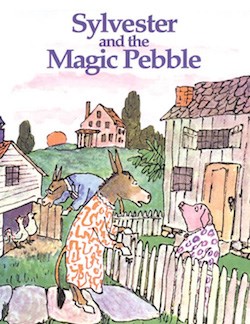My first encounter with award-winning author William Steig was in 1970, through his third book, Sylvester and the Magic Pebble, written in 1968 when Steig was 63 years old.
I was three years into my long library career and I was hooked. Here was a children’s book in which animals dressed and behaved like humans. Then, there was wonderful magic and witchcraft, a recurring theme in many of his subsequent books.
Sylvester, a donkey from the fictional community of Oatsdale, collects pebbles “of unusual shape and colour.” One day, he finds a pebble that grants wishes. Immediately afterwards, a lion scares Sylvester and, as a defence, he wishes himself into a rock — the only thing he could think of at the moment. Unfortunately, the magic pebble falls off the rock and Sylvester is unable to revert to his donkey form as the pebble must be in contact with the wish-maker to work. The rest of the story deals with the resulting aftermath: Sylvester’s attempt to change back into his true self and his parents’ search for their only son. For this book, Steig received the Caldecott Medal in 1970.
Steig was born in Brooklyn in 1907 to working class, Jewish-Polish immigrant parents who encouraged their children in the arts. He attended City College and the National Academy of Design. In 1930, Steig began drawing illustrations and cartoons for The New Yorker magazine, producing more than 2,600 drawings and 117 magazine covers.
When he was 61, he wrote the first of 35 children’s books. This explains, perhaps, why parents of very young children look like they are in their middle or senior years.
Steig experimented with a variety of subjects and settings, with family relationships being a popular theme in most of his books. He focused mainly on animal characters because he felt it gave him more freedom to do wackier things. Most often, his books featured animals heroes like brave pigs, dogs, donkeys or other strange creatures who have amazing adventures and find themselves in impossible, life-threatening situations from which they must escape.
Farmer Palmer’s Wagon Ride is so hazardous and hilarious that Farmer Palmer, a pig, and Ebenezer, an ass, barely make it home again.
Solomon the Rusty Nail is about a rabbit has an unusual talent of turning into a rusty nail and back into a rabbit. Zeke Pippin is a pig who owns a harmonica that, when played, puts the listeners to sleep.
In The Amazing Bone, Pearl the pig dawdles on her way home from school one spring day only to be confronted by highway (dog) robbers and, worse, a fox who captures her for his dinner. Just as the rusty nail saves Solomon from being eaten by a one-eyed cat and the magic harmonica rescues Zeke from bandits and a hungry fox, the amazing talking bone shrinks the fox to the size of a mouse and brings Pearl safely back to her parents.
Doctor De Soto features a mouse-dentist and his assistant, Mrs. De Soto, who must help a conniving fox with a toothache without being eaten. Doctor De Soto was recognized as a Newbery Honor Book. At 32 pages, it is one of the shortest to be honoured in that awards program.
An animated short film of Doctor De Soto, directed in 1984 by American animator Michael Sporn, was nominated for the Academy Award for Best Animated Short Film.
His 1990 picture book Shrek!, about a repugnant and monstrous green ogre who leaves home to see the world and ends up saving a princess, was adapted for the big screen and won a 2001 Academy Award for best animated feature film.
For adults, it would be a win-win situation to read Steig, not only for the slapstick comedy but for his spectacular and challenging vocabulary. He was unafraid to use rich, figurative language, long words, fantastic descriptions and poetic prose in children’s books. “Odoriferous wretch” sounds funnier as an insult than “smelly old fox” and calling one’s family “nincompoops,” a silly sounding and old-fashioned term, is less harsh than “a bunch of idiots.” There are literally hundreds of funny and concocted words that will keep you amused as your read his books. For this, my final Good Read article, I had a great time re-reading some of these wonderful stories.
William Steig wrote 35 children’s books, almost one every year since he started in 1968. His final book, When Everybody Wore a Hat, was published in 2003, the year he passed away. Check out and enjoy Steig’s books in your local library.
A Good Read is a column by Tri-City librarians that is published on Wednesdays. This is Teresa Rehman’s final good read column as she retired as of last Friday from Coquitlam Public Library.



